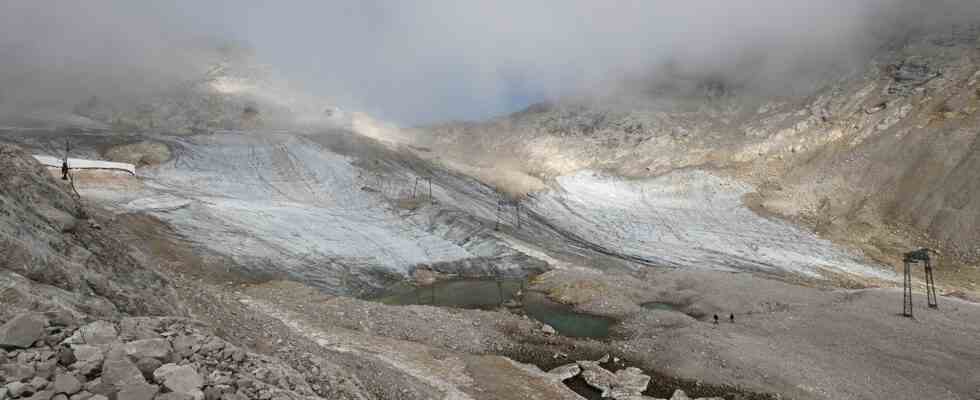Status: 08/20/2022 08:14 a.m
Sahara dust, a lack of cold air, temperatures that are too high: the glaciers in the Alps are melting faster than in previous years. Why is that? And can this process still be stopped?
The consequences of climate change for the Alpine glaciers only recently became tragically visible: on July 3, a rupture on the north side of the Marmolada in the Dolomites led to an accident that killed a total of eleven mountaineers. Together with water and debris, the ice masses had rushed into the valley at a speed of around 300 kilometers per hour. The incident makes it clear that the dangers of melting glaciers are difficult to predict.
Over the course of thousands of years, the glaciers in the Alps grew. On the Zugspitzplatt, the ice masses reached their greatest extent around 1820. However, developments since then have been alarming. In the last two decades in particular, ice loss has been massive. There is only one glacier left in the Bavarian Alps that could survive the next 15 years: the Höllentalferner on the shady north side of the Zugspitze.
Zugspitzplatt around 1890/1900: The ice losses in the past decades were great
Image: picture alliance / akg-images
Schneeferner ice-free four weeks earlier
The Northern Schneeferner, one of the last glaciers in the Bavarian Alps next to the Höllentalferner, was completely snow-free this year a full four weeks earlier than usual. Olaf Eisen, glaciologist at the Alfred Wegener Institute and professor at the University of Bremen, is alarmed: “In the European Alps we can already say that the summer season of 2022 will have a record melt. And stronger than in the summer of the century in 2003.”
First of all, the main driver for this is climate change. According to Eisen, the fact that droughts or above-average high temperatures not only last two to three weeks, but dominate Europe for months, is directly related to climate change. Christoph Mayer from the Bavarian Academy of Sciences in Munich makes it clear that there are usually one or two cold air dips in the Alps in summer: “The melt would have been interrupted for five to seven days. These dips are completely absent this year. Since June it melts all the time.”
View of the Höllentalferner (archive photo 2012): climate change is affecting the glaciers.
Image: picture alliance / Rolf Wilms
Reasons for the great glacier melt
With a view to the entire Alpine region, there is also the fact that the winter of 2021/2022 brought relatively little snow on average. The snow cover protects the ice from solar radiation – and reflects sunlight. If the protective layer is thinner, as it was this year, the ice melts faster.
Bad conditions, which are reinforced by Saharan dust on the snow layer of the glaciers. For Olaf Eisen, however, the dust from Africa is just the icing on the cake: “When the melt started in May, the glaciers had a dark surface due to the Sahara dust.
As a result, the snow surface is warmed up more because it is darker and reflects even less.” The melting is accelerated in this way. However, this aspect is not the main reason for the drastic development in the entire Alpine region: “Even without the Sahara dust, we would have been pretty sure this year had a record year,” says the glaciologist from the Alfred Wegener Institute.
Importance of the Sahara dust
Christoph Mayer, on the other hand, emphasizes that the importance of Saharan dust for glaciers varies from region to region: This year it played a decisive role, especially for the Bavarian glaciers. In contrast to other Alpine areas, the amount of snow on the northern edge of the Alps was actually not too little.
And this is where the Saharan dust comes into play: Where there has been little snow in winter, this snow cover melts very quickly anyway and the darker surface of the glacier is exposed to the sun’s rays early. As a result, the effect of the dust is only temporary. With normal snow conditions, such as on the Bavarian glaciers this year, the effect of increased snowmelt due to the dust layer means that the snow has disappeared very quickly here too.
Not only accidents like in the Dolomites
Not only demolitions like in the Dolomites can increase in the future due to the large melt. The global perspective shows: “Especially in areas that are very dry, glaciers save water from the winter and then make it available in the summer for the population, agriculture and industry. And once the glaciers have melted away, they can no longer store water fulfil,” says Eisen.
In the Alps, this effect is not quite as dramatic. The glaciers can still compensate for the current lack of rain to a certain extent. “But once you’ve lost the glaciers, that will also be a problem in the alpine area.” However, this development could take several decades.
The question remains as to how the melting of the glaciers can be stopped at all. Mayer and Eisen are skeptical: “With the scale we’re talking about, it’s completely insane to do something technically. The effort far exceeds what’s technically and financially feasible,” says Eisen. The reduction of greenhouse gases is the most effective way – and everything else is purely cosmetic.

